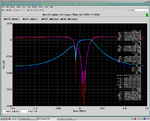zf3177
Newbie level 4
Hey guys, I just designed a active-RC complex filter based on TT biquad and work for GPS or Compass Receiver.
The filter has 4 ports include two in-phase and two quadrature inputs.
The in-phase consists of two AC signals, they are Mag 1.0 Phase 0.0 and Mag 1.0 Phase 180.
The Q-phase are Mag 1.0 Phase 180 and Mag 1.0 Phase 270
The similarity topics I had searched is not clear and many test methods based on LNA/Mixer, SFDR test often exists in DAC
Can somebody help me or provide some elaborate documents?
Thanks.
The filter has 4 ports include two in-phase and two quadrature inputs.
The in-phase consists of two AC signals, they are Mag 1.0 Phase 0.0 and Mag 1.0 Phase 180.
The Q-phase are Mag 1.0 Phase 180 and Mag 1.0 Phase 270
The similarity topics I had searched is not clear and many test methods based on LNA/Mixer, SFDR test often exists in DAC
Can somebody help me or provide some elaborate documents?
Thanks.

